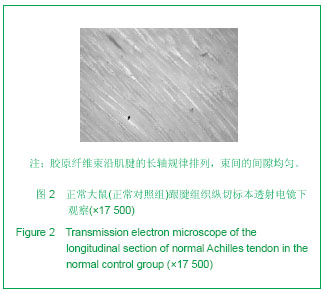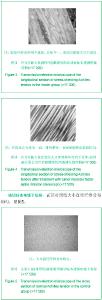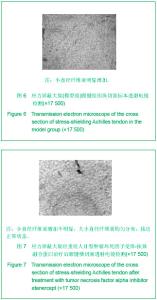Chinese Journal of Tissue Engineering Research
Previous Articles Next Articles
Effects of tumor necrosis factor alpha antagonist on the morphological change of Achilles tendon contracture induced by stress shielding
Li Ping, Zhao Hua-kun, Ma Yan-hong
- Department of Rehabilitation, Sixth Affiliated People’s Hospital, Shanghai Jiao Tong University, Shanghai 200233, China
-
Revised:2013-10-20Online:2013-12-10Published:2013-12-10 -
Contact:Ma Yan-hong, Chief physician, Department of Rehabilitation, Sixth Affiliated People’s Hospital, Shanghai Jiao Tong University, Shanghai 200233, China -
About author:Li Ping★, Studying for master’s degree, Department of Rehabilitation, Sixth Affiliated People’s Hospital, Shanghai Jiao Tong University, Shanghai 200233, China Sunshinelp0423@163.com -
Supported by:the Natural Science Foundation of Medical School of Shanghai Jiao Tong University in China, No. YZ1061*
CLC Number:
Cite this article
Li Ping, Zhao Hua-kun, Ma Yan-hong. Effects of tumor necrosis factor alpha antagonist on the morphological change of Achilles tendon contracture induced by stress shielding[J]. Chinese Journal of Tissue Engineering Research, doi: 10.3969/j.issn.2095-4344.2013.50.007.
share this article
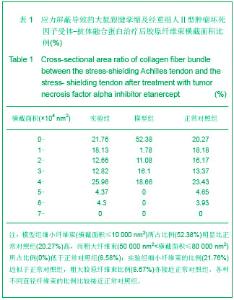
2.4 三组跟腱中胶原纤维束横截面积 从3组电镜横截面图片中随机选取200根胶原原纤维,用Image-pro plus 6.0图像分析软件测量其横截面面积。选取胶原纤维束前首先进行标尺的校正,使软件的标尺与电镜横截面图片右下角的标尺一致,则所得的横截面积为胶原纤维束的实际横截面积,然后选取200根胶原纤维束横截面的边缘,计算其横截面积并进行简单的统计。所得200根胶原纤维束的横截面积大小为(0-8)×104 nm2,按间距为1×104 nm2将纤维分成8组,每组横截面积的和占200根胶原纤维束的总横截面积的比例,见表1。 各组中等直径胶原纤维束(10 000 nm2<横截面积≤50 000 nm2)的比较:实验组中等直径胶原纤维束横截面积占(69.57±1.53)%,模型组占(47.62±1.30)%,正常对照组占(71.15±1.84)%,实验组中等直径纤维束横截面积与模型组比较,显著增加,差异有显著性意义(各组方差齐,P < 0.05);但仍小于正常对照组,但差异无显著性意义(P > 0.05)。"
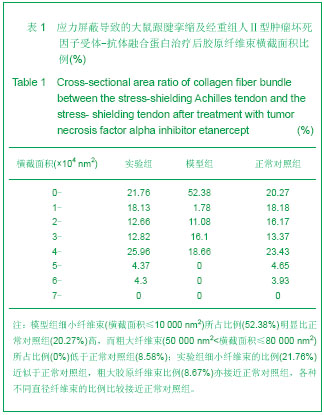
| [1] Hosaka YZ, Uratsuji T, Ueda H, et al. Comparative study of the properties of tendinocytes derived from three different sites in the equine superficial digital flexor tendon. Biomed Res. 2010;31(1):35-44.[2] Uchida H, Tohyama H, Nagashima K, et al. Stress deprivation simultaneously induces over-expression of interleukin-1beta, tumor necrosis factor-alpha, and transforming growth factor-beta in fibroblasts and mechanical deterioration of the tissue in the patellar tendon. J Biomech. 2005;38(4):791-798.[3] Knobloch K. Comment on: Monitoring Achilles enthesitis in ankylosing spondylitis during TNF-alpha antagonist therapy: an ultrasound study. Rheumatology (Oxford). 2010;49(7): 1418-1419. [4] Smolen JS, Nash P, Durez P, et al. Maintenance, reduction, or withdrawal of etanercept after treatment with etanercept and methotrexate in patients with moderate rheumatoid arthritis (PRESERVE): a randomised controlled trial. Lancet. 2013; 381(9870):918-929.[5] Chang B, Park HY, Jeon K, et al. Interferon-γ release assay in the diagnosis of latent tuberculosis infection in arthritis patients treated with tumor necrosis factor antagonists in Korea. Clin Rheumatol. 2011;30(12):1535-1541.[6] Jung YS, Park W, Na K. Temperature-modulated noncovalent interaction controllable complex for the long-term delivery of etanercept to treat rheumatoid arthritis. J Control Release. 2013;171(2):143-151. [7] Tanida A, Kishimoto Y, Okano T, et al. Etanercept Promotes Bone Formation via Suppression of Dickkopf-1 Expression in Rats with Collagen-Induced Arthritis. Yonago Acta Med. 2013; 56(1):13-19.[8] Martínez-Santana V, González-Sarmiento E, Calleja-Hernández M, et al. Comparison of drug survival rates for tumor necrosis factor antagonists in rheumatoid arthritis. Patient Prefer Adherence. 2013;7:719-727. [9] The Ministry of Science and Technology of the people Republic of China.Guidance Suggestions for the Care and Use of Laboratory Animals.2006-09-30.中华人民共和国科学技术部. 关于善待实验动物的指导性意见. 2006-09-30.[10] Cui Q,Wang Z, Jiang D,et al. HGF inhibits TGF-β1-induced myofibrobroblast differentiation and EMG deposition via MMP-2 in Achilles tendon in rat. Eur J Appl Physiol.2011; 111(7):1457-1463.[11] 王伟,马燕红.大鼠跟腱应力屏蔽挛缩模型的建立[J].中国康复理论与实践,2009:15(6):521-523.[12] 晏小艳,马燕红.IL-1受体拮抗剂干预跟腱挛缩的实验研究[J].中国康复,2011,26(4):25-28.[13] Palmes D, Spiegel HU, Schneider TO,et al. Achilles tendon healing:Long-term biomechanical in a new mouse model.J Orthop Res.2002;20(5):939-946.[14] Ricco S, Renzi S, Del Bue M, et al. logeneic adipose tissue-derived mesenchymal stem cells in combination with platelet rich plasma are safe and effective in the therapy of superficial digital flexor tendonitis in the horse. Int J Immunopathol Pharmacol. 2013;26(1 Suppl):61-68. [15] Noh MK, Jung M, Kim SH, et al. Assessment of IL-6, IL-8 and TNF-α levels in the gingival tissue of patients with periodontitis. Exp Ther Med. 2013;6(3):847-851. [16] Rich T, Henderson LB, Becker DL, et al. Indicators of replicative damage in equine tendon fibroblast monolayers. BMC Vet Res. 2013;9(1):180. [17] Schulze-Tanzil G, Al-Sadi O, Wiegand E, et al. The role of pro-inflammatory and immunoregulatory cytokines in tendon healing and rupture: new insights. Scand J Med Sci Sports. 2011;21(3):337-351. [18] de Araújo RF Júnior, Souza TO, de Moura LM, et al. Atorvastatin Decreases Bone Loss, Inflammation and Oxidative Stress in Experimental Periodontitis. PLoS One. 2013;8(10):e75322.[19] Akhter N, Nix M, Abdul Y, et al. Delta-Opioid Receptors Attenuate TNF-α-Induced MMP-2 Secretion From Human ONH Astrocytes. Invest Ophthalmol Vis Sci. 2013;54(10): 6605-6611. [20] Tsuzaki M, Guyton G, Garrett W, et al.IL-1 beta induces COX2, MMP-1, -3 and-13, ADAMTS-4, IL-1 beta and IL-6 in human tendon cells.J Orthop Res.2003;21(2):256-264.[21] Li XM, Dong L, Shi HT, et al. Effect of neferine on hepatic stellate cells in collagen-I, TIMP-1 and MMP-2. Zhongguo Zhong Yao Za Zhi. 2013;38(13):2206-2209. [22] Ji Y, Wang T, Wei ZF, et al. Paeoniflorin, the main active constituent of Paeonia lactiflora roots, attenuates bleomycin-induced pulmonary fibrosis in mice by suppressing the synthesis of type I collagen. J Ethnopharmacol. 2013; 149(3):825-832. [23] Furtwängler T, Chan SC, Bahrenberg G, et al. Assessment of the Matrix Degenerative Effects of MMP-3, ADAMTS-4, and HTRA1, Injected Into a Bovine Intervertebral Disc Organ Culture Model. Spine (Phila Pa 1976). 2013;38(22): E1377-1387. [24] Thornton GM, Shao X, Chung M,et al. Changes in meehanical loading lead to tendon-specific alterations in MMP and TIMP expression:Influence of stress-deprivation and intermittent cyclic hydrostatic compression on rat supraspinatus and Achilles tendons.Br J Sports Med. 2010; 44(10)698-703.[25] Kameda H. Etanercept. Nihon Rinsho. 2013;71(7): 1214-1217.[26] Horii M, Orita S, Nagata M,et al., Direct application of the tumor necrosis factor-alpha inhibitor, etanercept, into a punctured intervertebral disc decreases calcitonin gene-related peptide expression in rat dorsal root ganglion neurons. Spine (Phila Pa 1976). 2011;36(2):E80-85.[27] Rolle AS, Zimmermann B, Poon SH. Etanercept-induced Henoch-Schönlein purpura in a patient with ankylosing spondylitis. J Clin Rheumatol. 2013 ;19(2):90-93. [28] Zitelli KB, Zedek D, Ranganathan P, et al. Squamous cell carcinoma of the lip associated with adalimumab therapy for ankylosing spondylitis: a case report and review of TNF-α inhibitors and cutaneous carcinoma risk. Cutis. 2013;92(1): 35-39. [29] Ma YH, Yan XY, Zhao HK et al. Effects of interleukin-1 receptor antagonist on collagen and matrix metalloproteinases in stress-shielded achilles tendons of rats. Orthopedics. 2012;35(8):e1238-1244.[30] Miyatake S, Tohyama H, Kondo E, et al. Local administration of interleukin-1 receptor antagonist inhibits deterioration of mechanical properties of the stress-shielded patellar tendon. J Biomech. 200;41(4):884-889. |
| [1] | Liu Chunyu, Han Xiaoyan, Wang Lin. Basic science related to tendinopathy: microbiomechanics and stress shielding [J]. Chinese Journal of Tissue Engineering Research, 2020, 24(5): 766-772. |
| [2] | Qiu Guorong, He Benxiang, Wang Chun. Biological mechanism of platelet-rich plasma for tendinopathy repair: a visual study based on scientific knowledge map [J]. Chinese Journal of Tissue Engineering Research, 2020, 24(5): 787-795. |
| [3] | Wang Xiaolong, Han Chaoqian, Hao Zengtao, Yin Chao, Wen Shuzheng, Wang Jihong, Fan Dongsheng, Wang Yongfei, Jiang Dong, Zhang Guorong, Yan Xuedong, Sun Tao, Zhang Zhiyong, Jing Shangfei . Percutaneous woven modified Kessler suture for a small medial incision of the Achilles tendon in treatment of acute closed Achilles tendon rupture [J]. Chinese Journal of Tissue Engineering Research, 2020, 24(23): 3667-3672. |
| [4] | Chen Xiaolan, Liang Xiaotian, Zhang Ning, Liu Haitao, Qu Yi, Wang Bo, Wang Lin. Regulatory mechanism of the extracellular matrix during the development of bone-tendon junction overuse injury [J]. Chinese Journal of Tissue Engineering Research, 2020, 24(20): 3174-3179. |
| [5] | Liu Chunyu, Han Xiaoyan, Wang Lin. Tendinopathy: debate on concepts and pathogenesis [J]. Chinese Journal of Tissue Engineering Research, 2020, 24(2): 282-288. |
| [6] | Wu Kai, Liao Liqing, Li Yikai . X-ray evaluation of the location and etiology of calcaneal spurs [J]. Chinese Journal of Tissue Engineering Research, 2020, 24(18): 2906-2910. |
| [7] | Tang Jinlong, Yang Guanjie, Liu Lei, Xu Shizhuang, Zhao Fengchao. Change of related functions and double lower limb length after total knee arthroplasty [J]. Chinese Journal of Tissue Engineering Research, 2020, 24(15): 2310-2316. |
| [8] | You Tian, Zhang Honglei, Bai Lu, Zhang Xintao, Jiang Xiaocheng, Wang Shuang, Zhang Wentao. Massage effect on transforming growth factor beta1 signaling pathway in a rabbit model of gluteal muscle contracture [J]. Chinese Journal of Tissue Engineering Research, 2020, 24(11): 1683-1688. |
| [9] | Li Peng, Yang Shuye, Zhang Kai, Jia Long, Du Gangqiang, Liu Dong, Zhang Xinjun, Zhang Degang, Wang Zhigang. Influence of different wear particles on human peripheral blood mononuclear cells in vitro [J]. Chinese Journal of Tissue Engineering Research, 2019, 23(6): 894-900. |
| [10] | Zhou Jin, Fu Lin, Zhou Zhen, Li Qiurong. One-year evaluation of recombinant human tumor necrosis factor-alpha receptor II decrement combined with thalidomide increment in the treatment of active ankylosing spondylitis [J]. Chinese Journal of Tissue Engineering Research, 2019, 23(35): 5664-5669. |
| [11] | Meng Qingxi1, Wang Weiheng2, Sun Aijun3, Xi Yanhai1, Ye Xiaojian1. Protective effects of methane saturated saline on endotoxin-induced acute lung injury in rats [J]. Chinese Journal of Tissue Engineering Research, 2019, 23(3): 396-403. |
| [12] | Gao Hua1, 2, Li Yanxia1, Wang Dan1, Yang Xinling1 . Protective effects and the mechanism of lipoic acid on cell model of Parkinson’s disease induced by lipopolysaccharide [J]. Chinese Journal of Tissue Engineering Research, 2019, 23(3): 447-452. |
| [13] |
Zhang Yun, Chang Qun’an, Li Shengmei, Zhang Yuan.
Tumor necrosis factor-alpha inhibits osteogenic differentiation of periodontal ligament stem cells through activating nuclear factor-kappa B signaling pathway
[J]. Chinese Journal of Tissue Engineering Research, 2019, 23(25): 3993-3997.
|
| [14] | Liao Yaxian1, He Benxiang1, Wang Chun1, He Zongqi2. Visualization analysis of problems worthy of attention in the field of tendinopathy by CiteSpace software [J]. Chinese Journal of Tissue Engineering Research, 2019, 23(23): 3746-3753. |
| [15] | Zhao Maosheng, Feng Guochao, Deng Yinshuan, Zhen Ping. Application of platelet-rich plasma in repair of Achilles tendon injury [J]. Chinese Journal of Tissue Engineering Research, 2019, 23(20): 3229-3234. |
| Viewed | ||||||
|
Full text |
|
|||||
|
Abstract |
|
|||||



